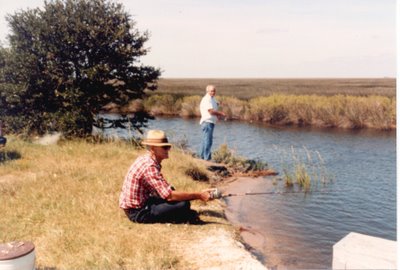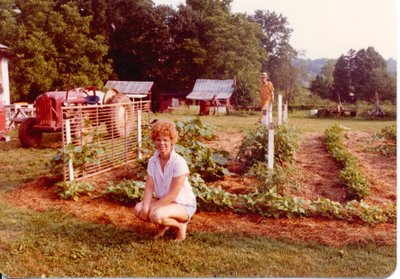Eat Shrimp?
 Lee's favorite leisure activity was fishing in the Yadkin River, the Tennessee River, and sometimes at the North Carolina coast. The picture above shows Lee and his son-in-law Don Shuford awaiting a nibble.
Lee's favorite leisure activity was fishing in the Yadkin River, the Tennessee River, and sometimes at the North Carolina coast. The picture above shows Lee and his son-in-law Don Shuford awaiting a nibble.Catfish was Lee's favorite fresh water catch. He could thread a fishhook and tie a knot with only one hand. As bait, he used earth worms, Catawba worms, grub worms, or shrimp.
I doubt Lee ever ate a shrimp. I can imagine him saying, "Shrimp are for catfish bait. I've seen expensive automobiles fill my parking lot on Saturday nights. Men dressed in suits and women in long dresses got out of their cars and walked across the street into the Robert. E. Lee Hotel. I sat in my toll-booth shack and watched through the window into the hotel ball room. Those people stood around a table and a large bowl of crushed ice. Shrimp were hanging over the edge of that bowl. Those people picked up those shrimp by the tail, dipped it in some red stuff, and ate that cold shit. Some of those damn people put shrimp on a see-through glass plate and walked around each other giggling as they used a colored tooth pick to lift shrimp off the plate and into their mouth. I wouldn't eat that shit! Shrimp are for catfish bait."
Threading a needle is hard for many people. Threading a fish hook and tying the knot wasn't easy for Lee until he discovered a technique. One-armed people are required to discover lots of maneuvers to get through life. Lee placed a new fish hook into an eyelet of his shoe, point first. This placement of the hook held the shank and eye in midair as Lee used his fingers to pass the nylon line through the hook's eye. He pulled excess line through the eye which helped him tie a fisherman's knot. He cut the excess line after he completed the knot.
As I thought about maneuvers above, I am reminded of a trick Lee performed that amazed people young and old. Few people could perform this act even after Lee showed them. When challenged to demonstrate his trick, he placed his left foot and calf behind his head. He did this even in old age. People were awestruck by his flexible hip joints.
Lee cleaned catfish this way: He started with a nail and hammer. Yes, he could "nail and hammer" with one hand. You try it sometime. He penetrated the catfish's head with a nail and then hammered the nail through the head and into a tree stump, for example. This secured the fish for the next step. He then used a sharpened butcher knife to cut through the skin behind the fish's head and gills. He used the knife blade to then lift a section of skin. He laid the knife down and reached for the pliers. He gripped the raised section with the pliers and pulled the entire skin off the fish. This action would be like you hooking your thumb inside your sock and with one motion removing the sock from your foot leaving the sock inside out.
Next, he cut off fins. Lee then pulled the fish loose from the stump or board, removed the nail, flipped the fish over, and nailed the fish again through the head. Now the fish was secured belly up. Lee cut along the belly center to expose the entrails. He used his fingers to rip away the internal parts. Lee flung these entrails to the ground for passing dogs or cats to eat. The final step was to cut the body from the head while still nailed.
After he repeated this process on all fish he caught, Frances washed and cooked the fish for the family meal.
As Lee journeyed through life, his friends included Clyde Tate, Worth Doub, and brother Buford. These three men helped Lee at "hog killing times".
Lee used Worth Doub's farm buildings to store potatoes until buyers were identified. Lee's potato harvests produced a few dozen bushels. He used his Ford tractor to plow his subterranean tuber crop to ground surface at harvest time. Lee, Dorothy, and Frances gathered these potatoes into baskets. (In my mind's eye, I see Lee rolling a potato in his hand and using his thumb to remove the fresh, moist dirt.) Lee hauled bushels of potatoes to Worth's buildings where he spread the new potatoes into a thin layer in the dark, dry, cool spaces of the buildings. This storage permitted curing and thickening of the skin. I recall Lee selling potatoes for $8.00 per bushel.
Lee taught Dorothy how to garden as she helped with the hoeing process. Lee used a special hoe that was smaller than most. The blade was worn small and the corners rounded from repeated use. The handle was cut shorter than standard. He gripped the handle by forming a fist around it, curved his wrist, and allowed the remaining handle to pass up his forearm past his elbow. His forearm was the control and strength behind each stroke.
Good gardening necessitates hoeing. This process breaks the crust around plants and brings fresh, moist dirt up close to the plant after tractor or tiller cultivation. Lee showed Dorothy how to hoe beets. He demonstrated how to use this tool to shift dirt, push clods away, and bring fresh moist soil near the plant. This process covered grass and weeds to prevent their competitive growth.
Lee followed behind Dorothy to inspect her performance. If weed growth was too close to the plant for hoe action, their gardening required them to bend over and pull the unwanted weed or grass by hand. If Dorothy missed this part of the job, Lee asked her to return to that section of the row for re-hoe. The job should be done right!
The picture below shows Lee on his tractor with Don Shuford, son-in-law, standing beside him.
Dorothy and Lee are in the other picture which shows a small garden near their house.
Eddie Gregory, Restaurateur of Old Richmond Grill, recalled the first time he ever saw Lee. Eddie said, "I was fourteen years old and working as a curb boy at Old Richmond Grill. I looked behind the grill building and there was Lee Anderson out there in the garden operating a roto-tiller with one hand. I couldn't believe it." Eddie continued, "I remember thinking it takes my daddy two hands to run a tiller." Eddie also said, "I remember Lee at that time drove a 1959 Buick, two-tone brown."
Samuel M. Gilbert was another close friend of Lee. Sam was a landowner, cattle farmer, and freight hauler truck company owner. For years Lee visited Sam's home on Sunday mornings to eat pancakes with Sam and his wife, Vivian. After Vivian's death in June 1989, Lee continued that Sunday morning tradition.
Return here on Friday, June 23 when I write about Lee's death.
Have a good day!


Labels: Lee Anderson


0 Comments:
Post a Comment
<< Home